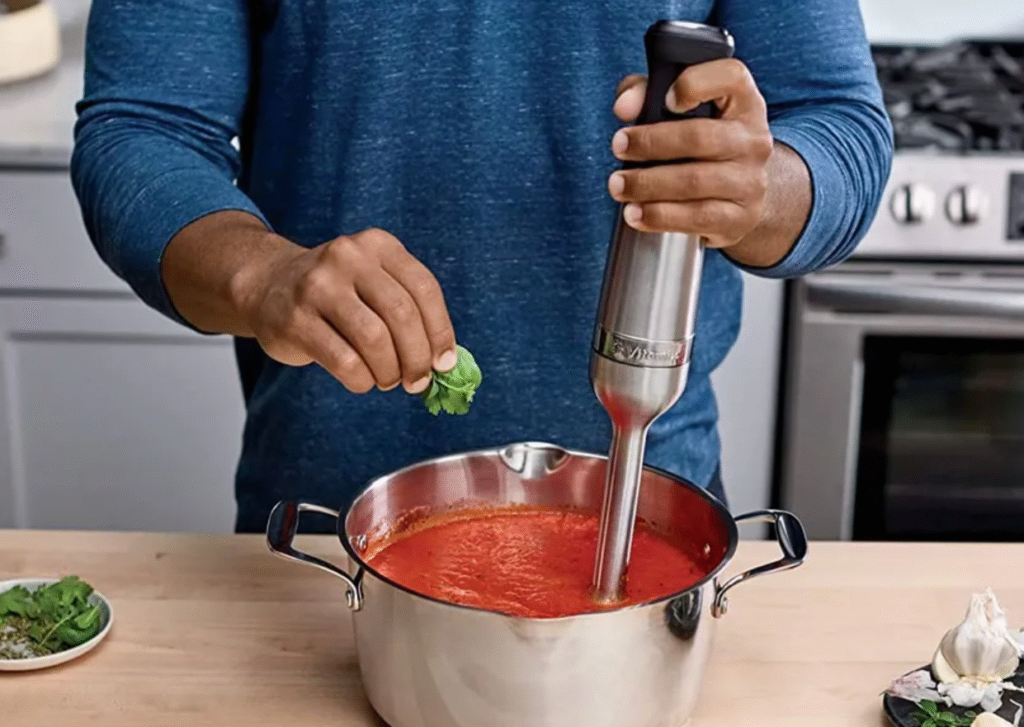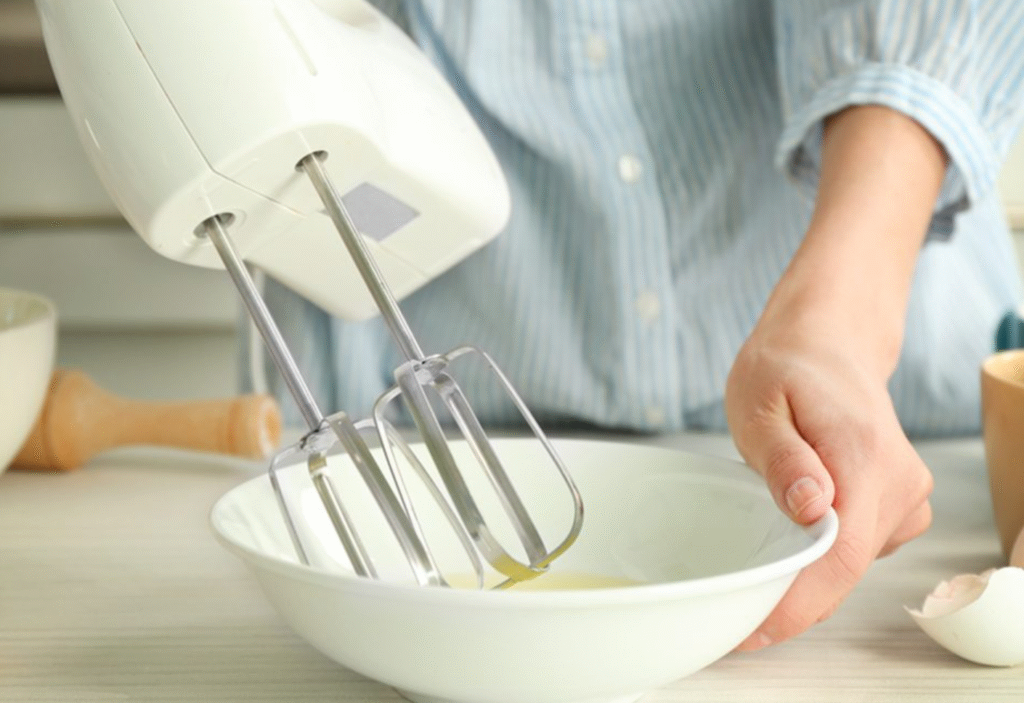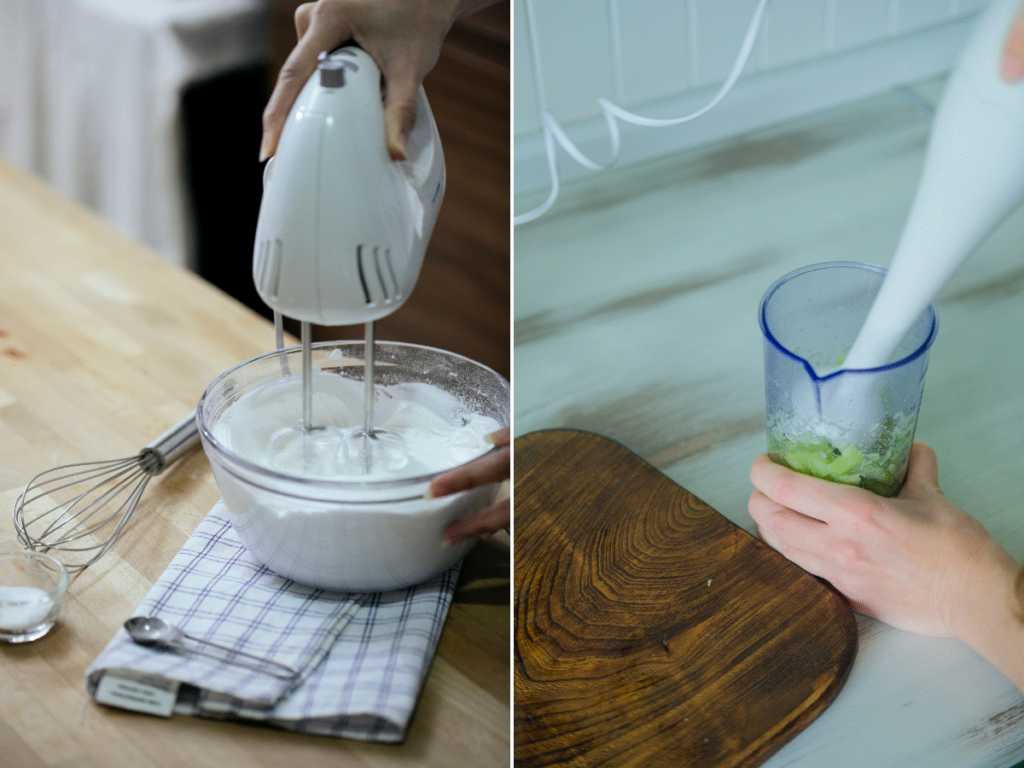Table of Contents
When it comes to small appliances, there are two main types of mixers: immersion blender vs hand mixer. Both have their pros and cons, so which one is right for you? Let’s take a closer look at the difference between immersion blenders and hand mixers.
What is an Immersion Blender?
An immersion blender, also known as a stick blender, is a handheld kitchen appliance that is used for blending and puréeing food. It is typically cylindrical in shape with a blade at one end and a handle at the other. The blade is submerged in the food that is being blended, and the handle is used to move the blender up and down, causing the blade to chop and blend the food.
Immersion blenders have a blade at the end of a shaft. You insert the shaft into the container that you want to blend the ingredients in, and then you start blending by moving the immersion blender up and down. The blade chops and blends the ingredients, and the movement of the immersion blender ensures that everything is evenly blended.
Immersion blenders come in different sizes, so you can find one that is perfect for your needs. They also come in different prices, so you can find one that fits into your budget.

Immersion Blender Uses
The immersion blender is a handheld blender that can be used to blend ingredients or purée food in a container. It’s a convenient tool if you don’t want to transfer hot soup to a blender or if you want to avoid dirtying another dish.
To use an immersion blender, simply place it in the container of food and turn it on. Move it up and down or around until the ingredients are blended to your desired consistency. Be careful not to let the blade touch the bottom or sides of the container, as this can damage the blade.
When you’re finished, turn off the blender and unplug it before removing it from the food. Rinse off the blade immediately to avoid staining.
How to Use an Immersion Blender?
If you’re new to using an immersion blender, the following tips will help you get the most out of this versatile kitchen gadget.
When using an immersion blender, it’s important to hold the device steady so that you don’t end up with unwanted splatters or spills. For best results, place the immersion blender in the pot or bowl before turning it on. Once it’s turned on, slowly move the blender up and down to avoid splattering.
Another thing to keep in mind is that immersion blenders are not meant for blending large quantities. If you’re working with a large batch of food, it’s best to use a regular blender instead.
When using an immersion blender, always be sure to keep your hands and fingers clear of the blades. The blades are sharp and can cause serious injury if mishandled.
Finally, be sure to clean your immersion blender after each use. All the parts of the blender can be washed in hot, soapy water. It’s also a good idea to rinse off the blades thoroughly to prevent any food residue from building up.
Immersion Blender: Pros and Cons
There are many immersion blenders on the market, and they all have their own pros and cons. Here are some things to keep in mind when deciding whether or not an immersion blender is right for you:
Pros:
- Immersion blenders are very versatile kitchen tools. They can be used to blend, chop, and Puree food, making them a great all-in-one tool.
- They are relatively inexpensive, especially compared to other kitchen appliances such as food processors.
- They are easy to use and clean. Immersion blenders typically have just a few simple parts that can be easily disassembled for cleaning.
Cons:
- Immersion blenders can be difficult to maneuver, especially if you have large pots or pans.
- They can also be dangerous if not used properly. Be sure to read the instructions carefully before using an immersion blender.
- If you are looking for a very powerful blender, an immersion blender may not be the best option. Some models do not have as much power as full-sized countertop blenders.
What is a Hand Mixer?
A hand mixer is an electrical kitchen appliance that is used for mixing ingredients or whipping cream. It consists of two beaters that rotate in opposite directions and a bowl in which the ingredients are placed. The bowl is usually made of plastic, metal, or glass.
The first hand mixers were created in the early 1900s. They became popular in the 1950s as more women began to work outside the home. Today, hand mixers are used by people of all genders and ages. They are especially useful for baking, as they can quickly and easily mix ingredients together.
There are many different types of hand mixers on the market today. Some have multiple speed settings, while others have only one. Some hand mixers come with attachments, such as a dough hook or a whisk, which can be used for different tasks.
When choosing a hand mixer, it is important to consider what you will be using it for. If you are an avid baker, you may want to choose a mixer with multiple speed settings and attachments. However, if you only plan on using it occasionally, a basic model will suffice.

Hand Mixer Uses
Hand mixers are one of the most versatile and commonly used kitchen appliances. While their primary function is to help with baking tasks such as mixing batter or dough, there are a number of other ways that hand mixers can be used to make your life in the kitchen easier. Here are some of the different hand mixer uses that you may not have thought of:
- Making whipped cream: A hand mixer is the perfect tool for making homemade whipped cream. Simply combine heavy cream, sugar, and vanilla extract in a bowl and mix on high speed until stiff peaks form.
- Beating eggs: Whether you’re making scrambled eggs or an omelet, a hand mixer can help you get the perfect consistency every time. Simply beat the eggs in a bowl until they’re the desired consistency and then cook as usual.
- Making salad dressing: Homemade salad dressings are simple to make with a hand mixer. Just combine your favorite ingredients in a bowl and mix on low speed until combined.
- Mixing pancake batter: A hand mixer comes in handy when you’re making pancakes from scratch. Mix the dry ingredients together in one bowl and the wet ingredients in another, then use the hand mixer to combine them just until everything is incorporated.
- Preparing soup: soups can be easily prepared with a hand mixer. Simply cook your vegetables and protein of choice until they’re tender, then add some broth and seasonings and mix on low speed until you have the desired consistency.
- Making meringue: Meringue is a light and airy topping that’s often used on pies and desserts. It’s made by whipped egg whites and sugar until stiff peaks form. A hand mixer is the perfect tool for this task.
- Blending smoothies: Smoothies are a quick and healthy snack or breakfast option, and they can be easily made with a hand mixer. Simply combine your favorite fruits and vegetables in a blender or food processor and mix on high speed until smooth.
- Chopping nuts: A hand mixer can also be used to chop nuts quickly and easily. Simply place them in a bowl and mix on low speed until they’re the desired consistency.
- Grating cheese: A hand mixer can be used to grate hard cheeses like Parmesan or cheddar. Simply place the cheese in a bowl and mix on low speed until it’s the desired consistency.
- Making pasta dough: Pasta dough can be easily made with a hand mixer. Simply combine flour, eggs, and water in a bowl and mix on low speed until a dough forms. Then turn the mixer up to medium speed and mix for another minute or so to form a smooth dough.
How to Use a Hand Mixer?
Using a hand mixer can be very easy once you get the hang of it. Here are some tips on how to use a hand mixer:
- Read the manual that comes with your hand mixer. This will give you an overview of all the different settings and what they do.
- Choose the right speed for what you’re mixing. If you’re mixing something light, like eggs, you’ll want to use a lower setting. For thicker items, like dough, you’ll need to use a higher setting.
- Begin slowly and then increase the speed as needed. This will help prevent spillage and splattering.
- When you’re finished mixing, turn off the mixer and unplug it from the outlet. Then, carefully remove the mixing attachments and wash them according to the manufacturer’s instructions.
Hand Mixer: Pros And Cons
When it comes to hand mixers, there are both pros and cons that you need to be aware of. Here are some of the key points that you should keep in mind:
Pros:
- You have more control over the mixing process when using a hand mixer.
- Hand mixers are typically more affordable than stand mixers.
- They are easier to store since they take up less space.
Cons:
- It can be more tiring to use a hand mixer for extended periods of time.
- You may not be able to achieve the same results as with a stand mixer (such as with bread dough).
- It can be more difficult to keep the beaters clean since they are not removable.
Immersion Blender vs Hand Mixer: The Differences
When it comes to kitchen appliances, there are a lot of options to choose from. If you’re looking for something to help with blending and mixing tasks, two popular choices are immersion blenders and hand mixers. But what’s the difference between these two devices?
An immersion blender, also known as a stick blender, is a handheld device that can be used to blend ingredients directly in a container. This is convenient if you want to avoid transferring hot liquids to a blender jug or food processor. Immersion blenders usually have shorter blades than traditional blenders, making them ideal for smaller tasks such as pureeing soup or making baby food.
A hand mixer, on the other hand, is designed for mixing batter or dough. It has several beaters that rotate around the bowl, allowing it to mix ingredients quickly and evenly. Hand mixers can also be used for whipping cream or egg whites.
So which one is better? It really depends on what you need it for.
Immersion Blender vs Hand Mixer: Do You Need Both?
When you’re deciding whether to buy an immersion blender or a hand mixer, it’s important to ask yourself what you’ll be using the appliance for.
An immersion blender is great for pureeing soups and sauces in the pot or bowl they are cooking in, while a hand mixer is better for beating eggs, creaming butter and sugar, and making cake batters. So if you think you’ll only need to blend or mix occasionally, then a hand mixer should do the trick. But if you plan on using your blending/mixing appliance regularly, then go with the immersion blender – it will save you time and counter space.

Can Immersion Blender Replace Hand Mixer?
One of the most frequently asked questions is whether an immersion blender can replace a hand mixer. The answer is yes and no. An immersion blender can do some things that a hand mixer can do, but it cannot do everything. Here is a list of things that an immersion blender can do that a hand mixer cannot:
- Can chop vegetables: An immersion blender can quickly chop vegetables into small pieces. This is ideal for making soups, sauces, and dips.
- Can puree fruits and vegetables: An immersion blender can puree fruits and vegetables into smooth consistency. This is perfect for making baby food, smoothies, and juices.
- Can make emulsions: An immersion blender can make emulsions, such as mayonnaise and vinaigrettes.
- Can make whipped cream: An immersion blender can make whipped cream in just a few minutes.
- Can blend hot liquids: An immersion blender can blend hot liquids without splattering them all over the place. This is perfect for making soups and sauces.
However, there are some things that a hand mixer can do that an immersion blender cannot. These include:
- Mixing dough: A hand mixer is better at mixing dough than an immersion blender. This is because the blades of a hand mixer are designed to more thoroughly mix ingredients together.
- Beating egg whites: hand mixer is better at beating egg whites than an immersion blender. This is because the blades of a hand mixer are designed to more thoroughly mix ingredients together.
- Mixing large quantities: A hand mixer is better at mixing large quantities of ingredients than an immersion blender. This is because a hand mixer can hold more ingredients in its bowl than an immersion blender.
If you only need to do one or two of the things on the list above, then an immersion blender may be all you need. However, if you need to do all of the things on the list, then a hand mixer may be a better option for you.
In Summary
So, which one should you buy? If you want something that’s easy to use and doesn’t take up a lot of space, an immersion blender is the way to go. But if you need more power or are looking for a mixer that can do more than just blend, a hand mixer might be better for you. Overall, it comes down to what you need and what your budget is. No matter which type of mixer you choose, we hope this article has helped make your decision easier. Thank you for reading “Immersion Blender vs Hand Mixer: What’s the Difference?”
Thank you for visiting Ohsnap Cupcakes!